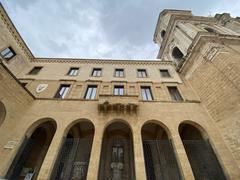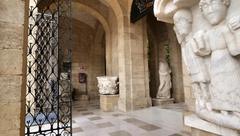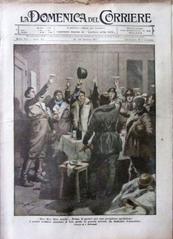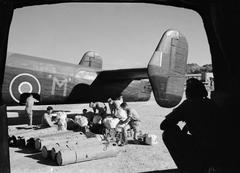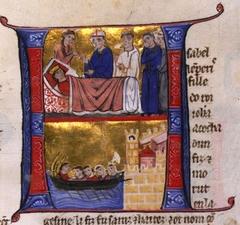
Comprehensive Guide to Museo Archeologico Provinciale F. Ribezzo in Brindisi, Italy
Date: 19/07/2024
Introduction
Are you planning a trip to Brindisi, Italy, and looking for a unique cultural experience? Look no further than the Museo Archeologico Provinciale Francesco Ribezzo. This museum offers a captivating journey through time, showcasing the rich history of Brindisi and its surrounding regions. Named after the renowned Italian archaeologist Francesco Ribezzo, the museum is a treasure trove of historical artifacts that narrate the story of the region from prehistory to the late Roman period (source). Whether you’re a history enthusiast or a casual visitor, the museum’s extensive collections and exhibits provide a unique glimpse into the past.
Table of Contents
- Introduction
- A Brief History of the Museo Archeologico Provinciale F. Ribezzo
- Practical Information
- Travel Tips
- Visitor Information
- FAQ
- Conclusion
A Brief History of the Museo Archeologico Provinciale F. Ribezzo
The Museo Archeologico Provinciale Francesco Ribezzo, named after the renowned Italian archaeologist Francesco Ribezzo, boasts a rich history intertwined with the archaeological discoveries of the Brindisi region.
The museum’s origins can be traced back to the late 19th century, a period marked by a surge in archaeological interest and excavations across Italy. While an exact date remains elusive, sources point to the museum’s founding around 1882, with archaeologist Giuseppe Ceci playing a pivotal role. Initially housed in the Ateneo Bruniano building, the museum’s collection primarily comprised artifacts unearthed during excavations in the Brindisi area.
Over the years, the museum’s collection steadily grew, prompting a move to a larger location in 1929. This new home, the Palazzo Granafei-Nervegna, a magnificent 16th-century palace, provided a more fitting backdrop for the expanding collection.
The museum’s trajectory took a significant turn in 1953 when it was renamed in honor of Francesco Ribezzo. Ribezzo, a distinguished scholar of the Messapic language and history, dedicated his life to studying the ancient cultures of Puglia, the region where Brindisi is located. His contributions to the field of archaeology significantly enriched the understanding of the region’s past.
The museum underwent a major renovation and expansion project between 1992 and 1998, further enhancing its capacity to showcase its impressive collection. This renovation modernized the museum’s facilities and allowed for a more engaging and informative visitor experience.
Collections and Exhibits
The museum’s layout is chronological, guiding visitors through different eras and their impact on the region.
Prehistoric and Bronze Age
This section showcases the earliest traces of human presence in the Brindisi region. Key exhibits include:
- Neolithic artifacts: Discoveries from the Guadone cave, including pottery fragments and tools, offer insights into the lives of the region’s earliest inhabitants.
- Bronze Age relics: The collection features ceramics, weapons, and ornaments from the nearby archaeological site of Santa Sabina, illustrating the development of a more structured society during this period.
Messapian Civilization
A significant portion of the museum is dedicated to the Messapians, an indigenous people who inhabited the region from the 7th century BC. Highlights include:
- Ceramics: The museum boasts an impressive collection of Messapian pottery, known for its distinctive geometric designs and red-figure decorations.
- Funerary finds: Discoveries from Messapian tombs, including intricately crafted jewelry, weapons, and terracotta figurines, shed light on their burial practices and beliefs about the afterlife.
- Epigraphic inscriptions: The museum houses several examples of Messapian script, offering glimpses into their language and culture.
Greek Influence
Brindisi, known as Brentesion in ancient Greek, played a crucial role in Greek trade and colonization. This section explores the Hellenic influence on the region:
- Attic pottery: The presence of Athenian pottery, particularly black-figure and red-figure vases, testifies to the vibrant trade links between Brindisi and the Greek world.
- Terracotta figurines: The collection includes Greek-inspired terracotta figurines, showcasing the artistic exchange and cultural assimilation during this period.
Roman Period
With the Roman conquest of Brindisi in the 3rd century BC, the city became a crucial port for trade and military expeditions. The museum’s Roman collection reflects this pivotal era:
- Sculptures: Admire Roman marble statues, including portraits of emperors and prominent figures, showcasing the artistry and grandeur of the Roman Empire.
- Mosaics: The museum houses exquisite Roman mosaics, unearthed from local villas and public buildings, depicting scenes from mythology, daily life, and nature.
- Epigraphic collection: Inscriptions on stone tablets and other materials provide valuable information about Roman administration, law, and social life in Brindisi.
- Maritime artifacts: Given Brindisi’s importance as a port, the museum displays a collection of Roman maritime artifacts, including anchors, amphorae (transport jars), and navigational instruments, highlighting the city’s role in ancient trade networks.
The Bronze Capra
One of the museum’s most prized possessions is the bronze sculpture of a she-goat dating back to the 2nd century AD. This exceptionally well-preserved artifact, discovered in the Brindisi harbor, is believed to be a votive offering to the gods for safe sea voyages.
Practical Information
Visiting Hours
- Monday to Friday: 9:00 AM - 5:00 PM
- Saturday and Sunday: 10:00 AM - 6:00 PM
- Closed on public holidays.
Ticket Prices
- Adults: €10
- Seniors (65+): €7
- Students (with valid ID): €5
- Children (under 12): Free
Accessibility
The museum is wheelchair accessible with ramps and elevators available.
Travel Tips
- Guided Tours: Enhance your visit with a guided tour. Available in multiple languages, these tours provide in-depth insights into the museum’s collections.
- Nearby Attractions: Explore other historical sites in Brindisi, such as the Roman Column and the Brindisi Cathedral, both within walking distance of the museum.
- Photography: Photography is allowed, but flash and tripods are prohibited. Capture the beauty of the artifacts and share your experience on social media.
- Special Events: Check the museum’s official website for information on special exhibitions, workshops, and events that may coincide with your visit.
Visitor Information
Getting There
By Car
- From the A14 motorway, take the Brindisi Centro exit and follow the signs for the city center.
- The museum is located within the city walls. Parking is available on the street or in nearby parking garages.
By Train
- Brindisi Centrale railway station is a 15-minute walk from the museum.
By Bus
- Several bus lines stop near the museum. Check the local bus schedule for routes and times.
Where to Stay
Brindisi offers a range of accommodation options, from budget-friendly guesthouses to luxury hotels. Many hotels are located within walking distance of the museum and other city center attractions.
Where to Eat
There are numerous restaurants, cafes, and bars in the vicinity of the museum, offering a variety of Italian and international cuisine.
FAQ
Q: What are the Museo Archeologico Provinciale F. Ribezzo visiting hours? A: The museum is open Monday to Friday from 9:00 AM to 5:00 PM, and on weekends from 10:00 AM to 6:00 PM. It is closed on public holidays.
Q: How much are tickets for the Museo Archeologico Provinciale F. Ribezzo? A: Ticket prices are €10 for adults, €7 for seniors (65+), €5 for students (with valid ID), and free for children under 12.
Q: Is the museum accessible for visitors with disabilities? A: Yes, the museum is wheelchair accessible with ramps and elevators available.
Q: Are there guided tours available at the museum? A: Yes, guided tours are available in multiple languages. Check the official website for more details.
Conclusion
The Museo Archeologico Provinciale F. Ribezzo is a must-visit destination for history enthusiasts and cultural explorers alike. From its rich collection of artifacts to its engaging exhibitions, the museum offers a unique glimpse into the past of Brindisi and the broader Puglia region. Plan your visit today and immerse yourself in the fascinating world of archaeology. For more information and to stay updated on upcoming events, visit the official website or follow the museum on social media.
References
- Visiting Museo Archeologico Provinciale F. Ribezzo - History, Tickets, and Tips, 2024, source
- Exploring the Museo Archeologico Provinciale F. Ribezzo - Collections, Tickets, and Visiting Hours, 2024, source
- Visiting Museo Archeologico Provinciale F. Ribezzo - Hours, Tickets, and Travel Tips, 2024, source
